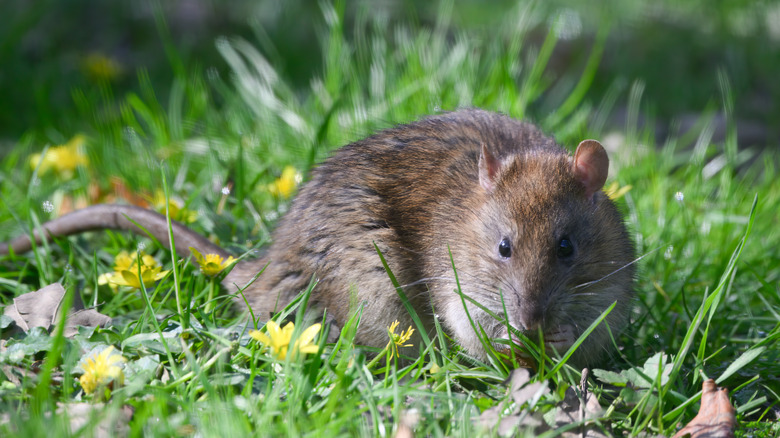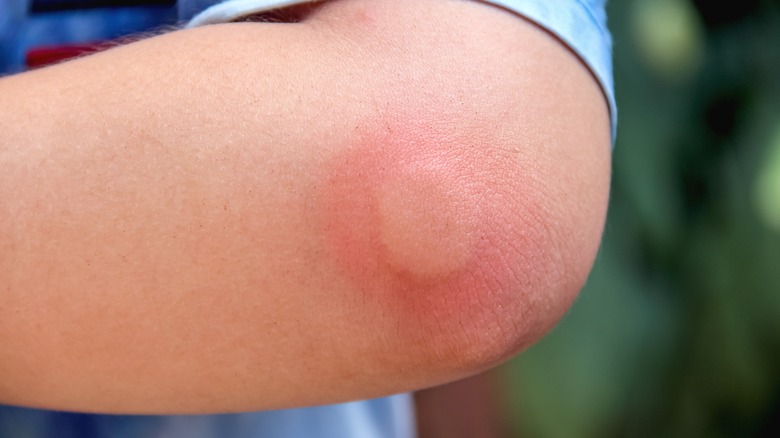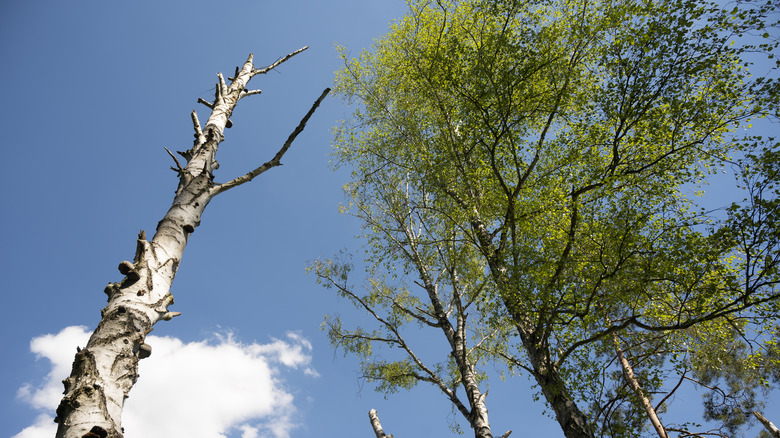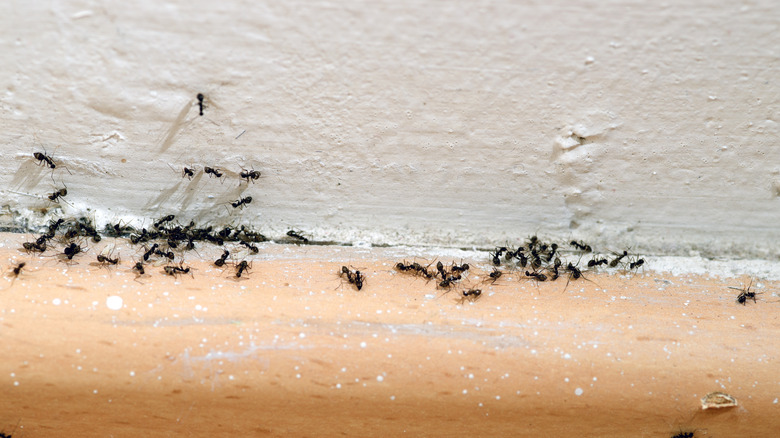Sneaky Signs Your Yard Has A Pest Problem
We may receive a commission on purchases made from links.
Here's the thing about pests — they're sneaky. You can do everything possible to keep pests like rats or snakes from getting into your home and yard. The truth is, though, they are going to find a way to invade no matter what. The way they go about it can have a destructive impact on your property.
Take your lawn and garden as an example. Pests can set upon your yard and cause lasting damage before you can even blink. Molehills can pop up all over your perfectly green lawn. Aphids can destroy your tomato plants. Disease can take hold of your most prized flowers and trees. While it can seem overwhelming or hopeless to try and deter pests, don't give up just yet.
If you know what to look for in your yard, you can, as the old cliché goes, head things off at the pass. You can protect your yard from pests by using their biggest weapon against them: sneakiness. Never forget that pests leave a trail — and you can find it. Therefore, if your yard shows any one of the following 12 signs, then you definitely have a pest problem. Thankfully, we have some tips to help you get rid of them.
Loads of ladybugs
Before we dive into this issue, we want to point out that the ladybugs themselves are not a pest. Ladybugs are a chief predator. They protect lawns and gardens from harmful pests. Having them around, therefore, is a net positive. The thing is, though, an excess of these small, colorful beetles is a hint that there is something amiss in your yard.
Having a swarm of ladybugs is a sign that there are plenty of pests for them to be feasting on. The main prey of the ladybug is the aphid, which is a tiny insect that can wreak havoc by destroying the foliage and stems of your garden plants. While ladybugs will take care of the aphid population, you would do well to provide them some backup.
You can encourage more ladybugs to visit your garden by planting things they like, such as yarrow, angelica, marigolds, and dill. You could also play backup to the ladybugs by creating a garlicky home solution to apply to your plants. Aphids hate it, as do several other pests, many of which, like deer, are too big for the ladybug to take on. Neem oil is another excellent aphid repelling option, and is really available for purchase online.
Patchy grass
You work hard to keep your lawn green. You water, fertilize, weed, mow, and admire the fruits of your labor at the end of the day. So, it could come as an extreme annoyance to find that your lawn suddenly has massive patches of discolored grass. While you might think that this is the result of something you did, it's important to realize that those patches are likely no fault of your own. They are a sign of pests.
There are a couple of different types of pests that can create patches of dead grass in your lawn. The most common is the white grub, which is a form of beetle larvae. If there are enough grubs, they will feed on the roots of the grass, causing the area to brown and die. One grub does not make an unhealthy lawn. Good sod can tolerate about 5 to 10 grubs per square foot. More than that is when problems start.
Another type of grass pest is the chinch bug, which will suck the juices out of the grass, again causing it to brown and die. You could use certain insecticides that can work against the grubs and chinch bugs. However, those with a greener thumb could work on better mowing practices that help build turf strength, making it all the more difficult for the bugs to take hold.
Molehills mean moles are nearby
Newsflash: "The Wind in the Willows" is a work of fiction. Moles certainly aren't dandified country gents enjoying the pleasures of the English countryside. In reality, moles can create enormous amounts of devastation to your property. Yet, since they burrow underground, a lot of that damage can go unseen until it is far too late. Still, if you look hard enough, there will be signs of mole activity.
Moles need points of entry and exit for the rare occasions on which they emerge from underground. When they do decide to come topside, they create small dirt mounds known as molehills. Though deeply damaging and unattractive, the presence of these hillocks not only shows you where the mole emerged, but gives you access to its network of tunnels underneath your yard.
There are a lot of things that could be attracting moles to your yard. A large presence of grubs, the same that are causing your grass to turn, is a primary attractor, as grubs are a fantastic food source for moles. You can deter moles by blocking the path of their tunnels with hardware cloth, using a mole trap, or working to remove their food sources. Trust us, the last thing you need is a gang of moles tearing up your yard to get at the pests that are already causing enough harm.
Ant hills in the front walkway
Whether we used our feet, or the garden hose, washing the ants away from our parents house was not only fun, but it was actually potentially doing our homes some good. Now, not all ants are pestilential. On the contrary, most ants are actually very helpful when it comes to a healthy outdoor landscape. However, that's when they are out in the lawn. When ants start to set up shop near your house, things start to get worrisome.
The more ants appear by your house, the more chances they have of making entry into your kitchen and making off with your food bits. The amount of damage made is entirely dependent upon the kind of ant that is present. As we said, most ants are just annoying, but don't do any real damage. Not so with carpenter ants.
Carpenter ants are bad news for your home. They burrow and eat through the wood that is holding your house together. Out in the yard, their presence is not much to worry about. Just make sure you are keeping an eye out that the ants are staying well away from your house. Don't be afraid to bust out the hose or some organic insecticide to protect your house from these damaging critters.
Slime trails are a sign of slugs and snails
If you have ever seen a shiny trail of what appears to be dried slime leading from your porch deck, up the sides of your terracotta planter pots, and into the potting soil, it is 100% certain that you are going to find a slug or snail nibbling away at your precious plant. Snails and slugs are among the biggest and most hated garden pests. Not overly discriminating when it comes to what they eat, slugs and snails will go after almost anything if it means they will get full bellies.
There are a few ways you can go about deterring these slimey pests. Obviously, there are chemicals, which are incredibly effective at killing the pests but will most assuredly have adverse side effects on the surrounding nature. For this reason, we recommend more organic options.
Cinnamon is an excellent kitchen item that can be used to deter slugs or snails. Spreading it directly on the soil of your at-risk plants will certainly keep them away. Other organic repellents, like Sluggo Maxx, are also popular. However, if you're one for keeping livestock, know that ducks are the single most effective way of managing these pests. They love to eat them, and will keep their population in check while protecting your garden.
Spots on your leafy plants
Not all pests have multiple legs, pincers, and antennae. There are some pests that cannot be seen with the naked eye, but will make their presence sorely felt before long. Mold, fungus, and disease can destroy entire landscapes if not dealt with in a timely manner. Once they take hold, they are very difficult to stop, which is why knowing the signs of when they appear is incredibly important.
The best way of figuring out if mold or other plant diseases are infecting your yard or garden is to look at the foliage of your plants. This could be trees, flowers, lettuces, or any plant that has a significant portion of its body covered in leaves. If the leaves start to spot, and rot begins to form, there is a high likelihood that some kind of disease has infected your plant.
Common garden diseases, such as powdery mildew, black spot, and rust, affect a great number of plants. Roses are particularly susceptible thanks to their generally delicate nature. Fortunately, the sowing of companion plants, or use of organic sprays like Earth's Ally, will help prevent the diseases from spreading further.
Tiny droppings likely mean rodents
If you head into your garden to find a corner of your raised bed nibbled, and several small, dark droppings among your plants, that is a sign that you have rodents making a home on your property. Most people don't like to hear this, but there is hardly a property in the world that has not housed rodents of some kind. The mess, aggravation, and potential harm they cause are all valid reasons to not like having rodents in our houses or gardens.
Yet, if there is one rodent that is more reviled than any others, it would have to be rats. They have an earned reputation for spreading diseases and for contaminating home pantries. Gardens and lawns, in particular, make for great spaces for rats to burrow and reproduce.
There is an exhaustive list of how to repel rats and other rodents from ever entering your property. You could bury metal hardware cloth in your garden to keep them from burrowing. You could spray vinegar solution along the perimeter of your home or garden. You could even resort to using traps and poison, but we recommend the latter only as a last resort. Just remember if you see droppings or evidence of chewing, rodents are likely around.
Bites and stings mean angry pests
While we may write off insect bites and stings as just a part of being outside, they could be an indicator of something else going on. If you are regularly leaving your garden or yard covered in stings, sores, and other rashes, there is a decent chance that there are an excessive amount of angry pests around that you may not have noticed before.
On the insect front, high populations of wasps, hornets, spiders, and mosquitoes can certainly lead to an increase in stings, bites, and rashes. While the presence of some of these insects, particularly spiders, is not necessarily a bad thing, you don't want to be dealing with so many that you are being attacked constantly.
It's the same thing with plants. There are many plant species that can cause hardship to both you and your landscape. Poison ivy, poison oak, cow parsnip, Queen Anne's lace, and various other plants can cause skin irritation, and even be deadly if consumed. If they grow in excess on your property, you should seriously consider having an expert come in to clear a good portion of them. Too much of one kind of plant can choke out other native species.
An abundance of birds
Things get a little tricky when it comes to how many birds you should be attracting to your yard on a regular basis. Some, like sparrows and hummingbirds, can be tremendous little helpers in the garden. Others, like common grackles and blue jays, are birds you don't want to see at your feeder. They are pests themselves, and could actually be very detrimental for other bird populations and the surrounding landscape. Yet, even with the attractive birds, having an abundance of them could mean that there are more pests at work in your yard than you might like.
Much like ladybugs, birds are excellent predators that take care of a number of different garden pests. Smaller songbirds tend to take care of the insect population, while larger birds like owls and hawks will go after rodents and rabbits.
While it is nice to have them around to help with the pest population, they don't always do so without inflicting damage on your lawn. Even the smaller birds can tear apart your lawn if there are too many grubs and other grass bugs. Woodpeckers can destroy your trees, or your house, if they promise food. So while it is nice to have birds show up to help with pests, they can definitely overstay their welcome.
Holes in your leaves are a sign of hungry pests
This is one of the most common signs of pests. If there are holes randomly appearing in the foliage of your garden plants or flowering fruit trees, some kind of pest is at work nibbling away on them. Typically, the culprits are caterpillars, ants, or other types of similar insects. The foliage provides them food, but at the expense of your plant's health. Remember, leaves act like large solar panels, providing the plant with the necessary nutrition it needs to survive.
There is also the possibility of mammalian pests, like deer, raccoons, porcupines, woodchucks, or rabbits having their way with your fruit trees and vegetables. They tend to leave total decimation behind, whereas insects work more slowly and are much easier to catch before all the foliage or fruit is gone.
For the larger pests, electric fencing is one of the best ways to deter them. You can purchase fences from suppliers like Premier1 Supplies, or on Amazon. The larger pests and insects can also be repelled using sprays of both organic and chemical variety. Again, we prefer organic methods, as they present the least amount of side effects and will be better for your health overall.
Signs of a sick tree
It is important that you don't simply look to your lawn and garden to see if there are signs of pests. We've brought up trees a few times already on this list, but it is worth mentioning again because of the damage they can do to property, and potentially to people. Sick trees are an incredible danger, especially if they are in proximity to your house. If they are not taken care of, they could pose a severe safety risk. This is why it is important to know the signs of a sick tree, and the types of creatures that can make it so.
Woodpeckers are an enormous tree-destroying pest.While they tend to favor trees that are already dying, they will still go after healthy trees if they promise a good place to nest and plenty of opportunities to hunt food. Insects like gypsy moths, eastern and western tent caterpillars, and wood borers can also make quick work of trees.
Thankfully, the evidence that these pests have taken up residence are quite obvious. The moths like to spin intricate webs to protect themselves, while the woodpeckers create massive holes in the trees that serve to weaken the structure. Have an expert come in and look at a tree you are suspicious of having become sick. If the tree is in any proximity to your house, it needs to be taken care of by a professional.
Is your house telling you something?
Can your house really tell you something about what is going on in your yard? It turns out, it can. When your house is set upon by pests, whether it's rodents or insects, realize that those creatures were not built into the foundation of your home. Your house sits in nature, and it is always from nature that pests make their way inside. So, if you have pests in your yard, you might not actually realize you have a problem until they start making their way into your home.
Rotted sills, mite damage, rat droppings, and holes drilled by wood borers are all signs that an infestation is occurring. If you've put off or just haven't realized that there was a pest situation on your property, this is the eventual result. The pests can make their way into your home, whether you like it or not.
This is why you need to pay attention to all of these sneaky signs. There is a high likelihood that, somewhere on your property, there are pests working on making things worse for your yard, garden, or even your home. The more knowledge and information you are armed with, the better you will be able to keep destructive things from happening to your property in the future.












